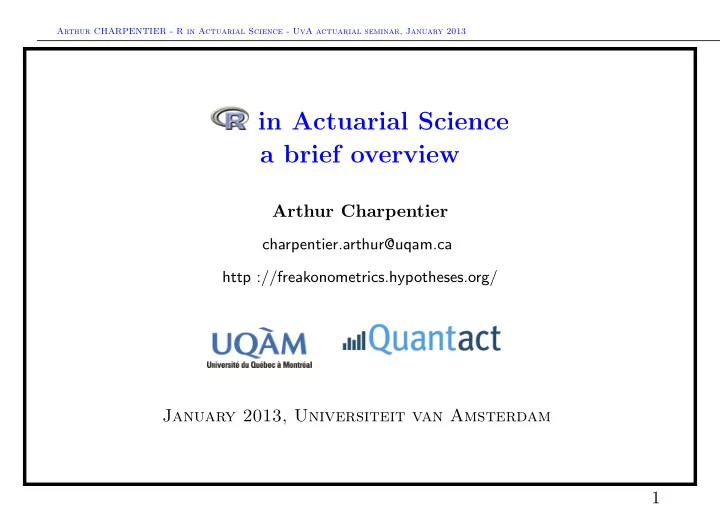

Arthur CHARPENTIER - R in Actuarial Science - UvA actuarial seminar, January 2013 in Actuarial Science a brief overview Arthur Charpentier charpentier.arthur@uqam.ca http ://freakonometrics.hypotheses.org/ January 2013, Universiteit van Amsterdam 1
Arthur CHARPENTIER - R in Actuarial Science - UvA actuarial seminar, January 2013 Agenda • Introduction to R • Why R in actuarial science ? ◦ Actuarial science ? ◦ A vector-based language ◦ A large number of packages and libraries for predictive models ◦ Working with (large) databases in R ◦ A language to plot graphs • Reproducibility issues • Comparing R with other statistical softwares ◦ R in the insurance industry and amongst statistical researchers ◦ R versus MsExcel Matlab , SAS , SPSS , etc ◦ The R community • Conclusion ( ?) 2
Arthur CHARPENTIER - R in Actuarial Science - UvA actuarial seminar, January 2013 R “ R (and S) is the ‘lingua franca’ of data analysis and statistical computing, used in academia, climate research, computer science, bioinformatics, pharmaceutical industry, customer analytics, data mining, finance and by some insurers. Apart from being stable, fast, always up-to-date and very versatile, the chief advantage of R is that it is available to everyone free of charge. It has extensive and powerful graphics abilities, and is developing rapidly, being the statistical tool of choice in many academic environments. ” 3
Arthur CHARPENTIER - R in Actuarial Science - UvA actuarial seminar, January 2013 A brief history of R R is based on the S statistical programming language developed by Joe Chambers at Bell labs in the 80’s R is an open-source implementation of the S language, developed by R obert Gentlemn and R oss Ihaka 4
Arthur CHARPENTIER - R in Actuarial Science - UvA actuarial seminar, January 2013 actuarial science ? – students in actuarial programs – researchers in actuarial science – actuaries in insurance companies (or consulting firms, or financial institutions, etc) 5
Arthur CHARPENTIER - R in Actuarial Science - UvA actuarial seminar, January 2013 Using a vector-based language for life contingencies A life table is a vector > TD[39:52,] > TV[39:52,] Age Lx Age Lx 39 38 95237 38 97753 40 39 94997 39 97648 41 40 94746 40 97534 42 41 94476 41 97413 43 42 94182 42 97282 44 43 93868 43 97138 45 44 93515 44 96981 46 45 93133 45 96810 47 46 92727 46 96622 48 47 92295 47 96424 49 48 91833 48 96218 50 49 91332 49 95995 51 50 90778 50 95752 52 51 90171 51 95488 6
Arthur CHARPENTIER - R in Actuarial Science - UvA actuarial seminar, January 2013 Using a vector-based language for life contingencies If age x ∈ N ∗ , define P = [ k p x ], and p[k,x] corresponds to k p x . The (curtate) expectation of life defined as ∞ ∞ � � e x = E ( K x ) = k · k | 1 q x = k p x k =1 k =1 and we can compute e = [ e x ] using > life.exp = function(x){sum(p[1:nrow(p),x])} > e = Vectorize(life.exp)(1:m) The expected present value (or actuarial value) of a temporary life annuity-due is n − 1 ν k · k p x = 1 − A x : n � ¨ a x : n = 1 − ν k =0 7
Arthur CHARPENTIER - R in Actuarial Science - UvA actuarial seminar, January 2013 Using a vector-based language for life contingencies and we can define A = [¨ a x : n ] as > for(j in 1:(m-1)){ adot[,j]<-cumsum(1/(1+i)^(0:(m-1))*c(1,p[1:(m-1),j])) } Define similarly the expected present value of a term insurance n − 1 � ν k +1 · k | q x A 1 x : n = k =0 and the associated matrix A = [ A 1 x : n ] as > for(j in 1:(m-1)){ A[,j]<-cumsum(1/(1+i)^(1:m)*d[,j]) } Remark : See also Giorgio Alfredo Spedicatos lifecontingencies package, and functions pxt , Axn , Exn , etc. 8
Arthur CHARPENTIER - R in Actuarial Science - UvA actuarial seminar, January 2013 Using a matrix-based language for prospective life models Life table L = [ L x ] is no longer a matrix (function of age x ) but a matrix L = [ L x,t ] function of the date t . > t(DTF)[1:10,1:10] 1899 1900 1901 1902 1903 1904 1905 1906 1907 1908 0 64039 61635 56421 53321 52573 54947 50720 53734 47255 46997 1 12119 11293 10293 10616 10251 10514 9340 10262 10104 9517 2 6983 6091 5853 5734 5673 5494 5028 5232 4477 4094 3 4329 3953 3748 3654 3382 3283 3294 3262 2912 2721 4 3220 3063 2936 2710 2500 2360 2381 2505 2213 2078 5 2284 2149 2172 2020 1932 1770 1788 1782 1789 1751 6 1834 1836 1761 1651 1664 1433 1448 1517 1428 1328 7 1475 1534 1493 1420 1353 1228 1259 1250 1204 1108 8 1353 1358 1255 1229 1251 1169 1132 1134 1083 961 9 1175 1225 1154 1008 1089 981 1027 1025 957 885 Similarly, define the force of mortality matrix µ = [ µ x,t ] 9
Arthur CHARPENTIER - R in Actuarial Science - UvA actuarial seminar, January 2013 10
Arthur CHARPENTIER - R in Actuarial Science - UvA actuarial seminar, January 2013 Using a matrix-based language for prospective life models Assume - as in Lee & Carter (1992) model - that log µ x,t = α x + β x · κ t + ε x,t , with some i.i.d. noise ε x,t . Package demography can be used to fit a Lee-Carter model, > library(demography) > MUH =matrix(DEATH$Male/EXPOSURE$Male,nL,nC) > POPH=matrix(EXPOSURE$Male,nL,nC) > BASEH <- demogdata(data=MUH, pop=POPH, ages=AGE, years=YEAR, type="mortality", + label="France", name="Hommes", lambda=1) > RES=residuals(LCH,"pearson") 11
Recommend
More recommend